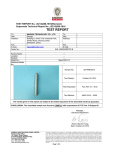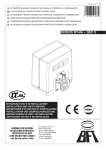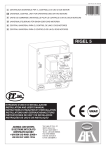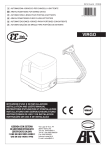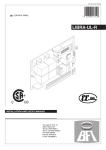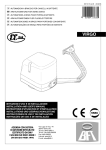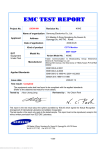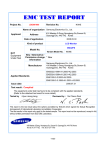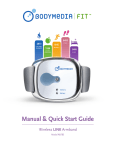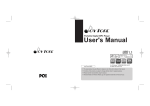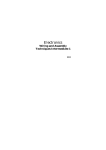Download FCC
Transcript
CONSUMER PRODUCTS SERVICES DIVISION TECHNO SOURCE Technical Report: (5211)210-0439 Date Received: Sample Description: Vendor: Manufacturer: . Buyer: Labeled Age Grade: Appropriate Age Grade: Client Specified Age Grade: Tested Age Grade: UPC Code: Test Finished Date: August 04, 2011 Page 1 of 14 July 27, 2011 20Q ASSORTMENT SPECIALTY 1. ) RED 2. ) BLUE 3. ) PINK N/A On File N/A 6+ OVER 6 YEARS OF AGE NOT SPECIFIED OVER 6 YEARS OF AGE 801561010961, 801561010978, 801561010985 1 AUG 2011 Sample Size: Style No(s): SKN/SKU No.: PO No.: Ref #: Country of Origin: 36 1096, 1097, 1098 N/A N/A N/A CHINA Assortment No.: Terminal Voltage: (1095) 4.50 V EXECUTIVE SUMMARY: The sample(s) MEET the following requirement(s): - The tested requirements of the applicable sections of the Rules and Regulations details in 47 C.F.R., Part 15 of the Federal Communication Commission (FCC) of United States of America and Industry Canada InterferenceCausing Equipment Standard ICES-003. BUREAU VERITAS HONG KONG LIMITED LYT/vh Bureau Veritas Hong Kong Limited Kowloon Bay Office 1/F Pacific Trade Centre, 2 Kai Hing Road, Kowloon Bay, Kowloon, Hong Kong Tel: (852) 2331 0888 Fax: (852) 2331 0889 www.bureauveritas.com/cps Law Yiu Tung Assistant Manager Electrical Department This report is governed by, and incorporates by reference, the Conditions of Testing as posted at the date of issuance of this report at http://www.bureauveritas.com/cps and is intended for your exclusive use. Any copying or replication of this report to or for any other person or entity, or use of our name or trademark, is permitted only with our prior written permission. This report sets forth our findings solely with respect to the test samples identified herein. The results set forth in this report are not indicative or representative of the quality or characteristics of the lot from which a test sample was taken or any similar or identical product unless specifically and expressly noted. Our report includes all of the tests requested by you and the results thereof based upon the information that you provided to us. You have 60 days from date of issuance of this report to notify us of any material error or omission caused by our negligence; provided, however, that such notice shall be in writing and shall specifically address the issue you wish to raise. A failure to raise such issue within the prescribed time shall constitute you unqualified acceptance of the completeness of this report, the tests conducted and the correctness of the report contents. TECHNO SOURCE Technical Report: (5211)210-0439 August 04, 2011 Page 2 of 14 SUMMARY OF TEST RESULTS The sample submitted COMPLIES with the tested requirements of the applicable sections of the Rules and Regulations detailed in 47 C.F.R., Part 15 of the Federal Communication Commission (FCC) of United States of America and Industry Canada Interference-Causing Equipment Standard ICES-003 Tests Required For Unintentional Radiator: Test Executed Test Requirement Test Method Limit Status Measurement of Radiated Emissions Section, 15.109 CFR47, FCC Part 15 Section 15.31, 47 CFR, FCC Part 15 ANSI C63.4-2003 See Section 15.109 CLASS B Meet Measurement of Conducted Emissions on AC Mains Section 15.107 CFR47, FCC Part 15 Section 15.31, 47 CFR, FCC Part 15 ANSI C63.4-2003 See Section 15.107 CLASS B N. A. N. A. = Not Applicable TECHNO SOURCE Technical Report: (5211)210-0439 August 04, 2011 Page 3 of 14 Test Results: Measurement of Radiated Emissions: Requirements: FCC PART 15, SECTION 15.109 Limit: Section 15.109 Class B Port under test: Enclosure Test equipment: Description EMI Test Receiver Bilog Antenna Biconical Antenna Log-Periodic Antenna Open Area Test Site (range = 3m) Full Anechoic Chamber (7m x 3m x 3m) Automatic Antenna Mast Automatic Turntable Antenna Mast / Turntable Controller Coaxial Cable No. 2 Coaxial Cable No. 6 Coaxial Cable No. 3 Coaxial Cable No. 4 Loop Antenna Brand Name Rohde & Schwarz Schaffner Rohde & Schwarz Rohde & Schwarz None Albatross Projects Rainer Schäfer Rainer Schäfer Rainer Schäfer Uniradio Unknown Suhner Suhner Schaffner Model No. ESCI CBL6112D HK 116 HL 223 None M-CDC RSM 010 RST 020 RSC None None None None HLA 6120 Test method: Location of test facilities: The EMC laboratory is located at the following address: No. 2106-2107, 21/F, Westin Centre, 26 Hung To Road, Kwun Tong, Kowloon, Hong Kong The test facility has been found in compliance with the requirement of Section 2.948 of the FCC rules. The information has been placed on file and listed by FCC with Registration No. 642151. The operational mode(s) under test: The operational modes under test are determined according to the typical use of the Equipment-Under-Test (EUT) with respect to the expected highest level of emission. During the test, various parts of the EUT system are exercised in a manner permitting detection of all system disturbances. TECHNO SOURCE Technical Report: (5211)210-0439 August 04, 2011 Page 4 of 14 The frequency range of radiated measurements: The frequency range of radiated measurements is determined pursuant to Section 15.33. For an unintentional radiator, unless otherwise specified, the spectrum shall be investigated from the lowest radio frequency signal generated or used in the device, without going below 9 kHz, up to the frequency list in the following table: Highest frequency generated or used in the device or on which the device operates or tunes (MHz) Upper frequency of measurement range (MHz) Below 1.705 30 1.707 – 108 1000 108 –500 2000 500 – 1000 5000 Above 1000 5th harmonic of the highest frequency or 40 GHz, which ever is lower. Limits of radiated Emissions: The limits of radiated emissions are specified in the appropriate Sections of the FCC rules that the EUT is subject to, and the provisions in Section 15.35. Unless otherwise specified in the Rules, on any frequency or frequencies below or equal to 1000 MHz, the limits are based on measuring equipment employing a CISPR quasi-peak detector. For frequencies above 1000 MHz the radiated limits are based upon the use of measurement instrument employing an average detector, with a minimum resolution bandwidth of 1MHz. When average radiated emission measurements are specified in Part 15, including emission measurements below 1000 MHz, there also is a limit on the radio frequency emissions, as measured using instrumentation with a peak detector function, corresponding to 20 dB above the maximum permitted average limit, unless a different peak emission limit is otherwise specified. Measurement method of radiated emissions: Measurements are carried out on the open area test site (OATS) located on the roof of the EMC laboratory, in accordance with CISPR 22 as a basic standard at a measurement range of 3 meters. The test site has, by verification measurements, satisfied the normalized site attenuation (NSA) requirements specified in the standard CISPR 22. For measurement at each test frequency, the antenna-to-EUT azimuth is varied through 360 . The antenna is also scanned between 1 m to 4 m in height above the ground plane to maximize the level of radiated disturbances. The reading on the measuring receiver is observed for about 15 s for each final measurement; the highest readings shall be recorded with the exception of any isolated spike which shall be ignored. For measurements of undesired spurious emissions, if the measurement results are 20 dB lower than the corresponding permissible limit levels, they can be confidently regarded as having satisfied the limit requirement applied. No records of these measurement results are required. For the measurements at frequencies with high ambient disturbance signals existing, verification tests may be carried out in the Full Anechoic Chamber (FAC) as an auxiliary method to confirm whether there is any emission of radiated disturbances from the EUT. If there is no maximum disturbance level from the EUT other than the corresponding intrinsic noise floor of measuring system (which is at least 20 dB below the limit level), then it can be stated confidently that the measurement result obtained at OATS is due to the signal levels of ambient signal sources, not from the EUT. TECHNO SOURCE Technical Report: (5211)210-0439 August 04, 2011 Page 5 of 14 Test Set-up: 50.6 d Bu V With hand-held or portable EUT exploratory radiated emission test shall be carried out, including rotation of the EUT through three orthogonal axes to determine the attitude that highest emission relative to the limit. The so found attitude and equipment arrangement shall be used in the final measurement. In frequency range of 9kHz to 30MHz, a calibrated Loop antenna shall be applied for measuring radiated emissions. The Loop antenna shall be positioned with its plane vertical. The centre of the loop shall be 1m above ground plane and 3m apart from the EUT placed on the turntable. The Loop antenna shall be rotated about its vertical axis to maximize the radiated emission measured. TECHNO SOURCE Technical Report: (5211)210-0439 August 04, 2011 Page 6 of 14 Results: Operational mode under test: On mode (with Sound, Light, Display) EUT operating condition: (a) System Configuration The EUT system is regarded as a portable apparatus and tested as a desktop device. The EUT is configured and tested as a stand-alone unit. (b) Antenna (if applicable): Not applicable TECHNO SOURCE Technical Report: (5211)210-0439 August 04, 2011 Page 7 of 14 Spurious Emissions of Unintentional Radiator: Pursuant to SECTION 15.109 The measurement results are found to be more than 20dB below the permissible limit. They can then be confidently regarded as having satisfied the limit requirement applied. No record of measurement results is therefore required. TECHNO SOURCE Technical Report: (5211)210-0439 August 04, 2011 Page 8 of 14 Conducted Emissions on AC mains port (150 kHz – 30 MHz) Standard: FCC PART 15, SECTION 15.107 Limit applicable: Section 15.107, Class B Port under test AC Input Test equipment: Description EMI Test Receiver Artificial Mains Network (AMN) Pulse Limiter Reference Ground Plane Digital Multi-meter Brand Name Rohde & Schwarz Rohde & Schwarz Rohde & Schwarz None Fluke Model No. ESCI ESH3-Z5 ESH3-Z2 None Fluke 26 III Test Set-up: Reference Ground Plane EUT 0.4m AMN 0.8m 0.8m Measuring Receiver Test method: Select the AC mains supply voltage by varying the AC mains voltage over the range of 0.9 to 1.1 times the rated voltage to maximize the level of disturbance voltage measured at about 160 kHz. Perform an initial measurement on each line with peak detectors to identify the frequencies where the maximum disturbances may occur. Then measure and record the maximum disturbances with quasi-peak and average detectors. The reading on the measuring receiver is observed for about 15 s for each measurement; the highest readings shall be recorded with the exception of any isolated spike which shall be ignored. The final measurements shall be carried out at least at all frequencies at which there is a maximum. The operational modes under test are determined according to the typical use of the EUT with respect to the expected highest level of emission. During the test, various parts of the EUT system are exercised in a manner permitting detection of all system disturbances TECHNO SOURCE Technical Report: (5211)210-0439 August 04, 2011 Page 9 of 14 Results: The test is not applicable to the product because it has no AC mains power port. END of Test Data TECHNO SOURCE Technical Report: (5211)210-0439 August 04, 2011 Page 10 of 14 The General FCC Requirements in Labeling and Instruction Manual for Part 15 Devices Subject to Verification (Informative) The following paragraphs provide general information of labeling on most of the devices subjected to verification authorization and requirements of FCC Part 15. The responsible party (i.e. the manufacturer or the importer within the United States) shall refer to the original and updated Rules (e.g. FCC Part 2, and Part 15, etc.) for acquiring information of updated or additional specific requirement for each individual device. Device Identification: All devices subject to verification are required to have an identification label pursuant to Section 2.954 of the Rules. Additional labeling requirements may be specified in the particular sections of the FCC rules governing the specific class of equipment. The label showing the equipment identification data may be combined with a label showing other information (serial numbers, other governments requirements, etc.), if desired. This unique identifier must be displayed on the device. Under NO circumstances shall verified equipment be labeled with a FCC Identifier (FCC ID), or in any manner which implies that such equipment has been approved by the FCC. The suggested identification label format for equipment subject to verification is illustrated as shown below: Model No. 123 Company’s name or trade name Country of origin # # Country of origin - U.S. Customs and the Federal Trade Commission regulations require all equipment produced in foreign countries to be marked with the country of origin. Label of Compliance Statement: Devices subject to FCC Part 15, Subpart B verification must be labeled with the statement(s) pursuant to Section 15.19 (a) of the Rules. FM broadcast radio receivers or the other receivers associated with the operation of a licensed radio service shall bear the following statement in a conspicuous location on the device: This device complies with Part 15 of the FCC Rules. Operation is subject to the condition that this device does not cause harmful interference. A stand-alone cable input selector switch for cable TV shall bear the following statement in a conspicuous location on the device: This device is verified to comply with Part 15 of the FCC Rules for use with cable television service. All other devices shall bear the following statement in a conspicuous location on the device: This device complies with Part 15 of the FCC Rules. Operation is subject to the following two conditions: (1) this device may not cause harmful interference, and (2) this device must accept any interference received, including interference that may cause undesired operation. TECHNO SOURCE Technical Report: (5211)210-0439 August 04, 2011 Page 11 of 14 The label on these products shall be permanently affixed to the product and shall be readily visible to the purchaser at the time of purchase, as described in Section 2.925(d) of the FCC Part 2. Note: "Permanently affixed" means that the label is etched, engraved, stamped, silkscreened, indelibly printed, or otherwise permanently marked on a permanently attached part of the equipment or on a nameplate of metal, plastic, or other material fastened to the equipment by welding, riveting, or a permanent adhesive. The label must be designed to last the expected lifetime of the equipment in the environment in which the equipment may be operated and must not be readily detachable. “Readily visible” means that the nameplate or nameplate data must be visible from the outside of the equipment enclosure Information to User Pursuant to Section 15.21 of the Rules, the users manual or instruction manual shall include the following or similar statement to caution the user: Caution: Changes or modifications not expressly approved by the party responsible for compliance could void the user's authority to operate the equipment. Pursuant to Section 15.105 of the Rules, the users manual or instruction manual of Class A digital devices shall include the following or similar statement, placed in a prominent location in the text of the manual: NOTE: This equipment has been tested and found to comply with the limits for a Class A digital device, pursuant to Part 15 of the FCC Rules. These limits are designed to provide reasonable protection against harmful interference when the equipment is operated in a commercial environment. This equipment generates, uses, and can radiate radio frequency energy and, if not installed and used in accordance with the instruction manual, may cause harmful interference to radio communications. Operation of this equipment in a residential area is likely to cause harmful interference in which case the user will be required to correct the interference at his own expense. For a Class B digital device or peripheral, the user manuals or instructions shall include the following or similar statement, placed in a prominent location in the text of the manual: NOTE: This equipment has been tested and found to comply with the limits for a Class B digital device, pursuant to Part 15 of the FCC Rules. These limits are designed to provide reasonable protection against harmful interference in a residential installation. This equipment generates, uses and can radiate radio frequency energy and, if not installed and used in accordance with the instructions, may cause harmful interference to radio communications. However, there is no guarantee that interference will not occur in a particular installation. If this equipment does cause harmful interference to radio or television reception, which can be determined by turning the equipment off and on, the user is encouraged to try to correct the interference by one or more of the following measures: - Reorient or relocate the receiving antenna. - Increase the separation between the equipment and receiver. - Connect the equipment into an outlet on a circuit different from that to which the receiver is connected. - Consult the dealer or an experienced radio/TV technician for help. TECHNO SOURCE Technical Report: (5211)210-0439 August 04, 2011 Page 12 of 14 The user manual may also be required to include other information for users if the device is subject to the provisions of any specific sections of the Rules. For example: - TV interface devices marketed as a kit, information for users pursuant to Section 15.25 shall be provided. - If special accessories, e.g. shielded cables and / or special connectors, are required for enabling the compliance to FCC Rules, they shall be explicitly specified in the user manuals or instructions pursuant to the Section 15.27. In cases where the manual is provided only in a form other than paper, such as on a computer disk or over the Internet, the information required by this section may be included in the manual in that alternative form, provided the user can reasonably be expected to have the capability to access information in that form. TECHNO SOURCE Technical Report: (5211)210-0439 August 04, 2011 Page 13 of 14 The Canadian EMC Requirements If devices have been tested and comply with FCC regulation (FCC Part 15), no retesting is required to show compliance with ICES-003. However, additional equipment label requirement is required which must be in form of a label affixed to the device in both English and French. Regulatory Statement A written notice indicating compliance must accompany each unit of digital apparatus to the end user. The notice shall be in the form of a label that is affixed to the apparatus. Where because of insufficient space or other constraints it is not feasible to affix a label to the apparatus, the notice may be in the form of a statement included in the user’s manual. Suggested test for the notice indicating compliance with the standard of ICES-003 ‘The Class [*] digital apparatus complies with Canadian ICES-003.” ‘Cet appareil numèrique de la classe [*] est conforme à la norme NMB-003 du Canada’ [*] Insert either ‘A’ or ‘B’ but not both as appropriate for the equipment requirements END TECHNO SOURCE Technical Report: (5211)210-0439 August 04, 2011 Page 14 of 14














